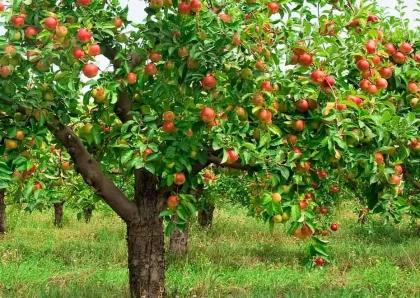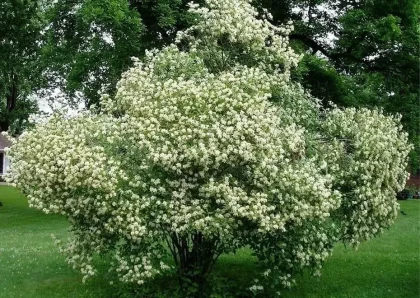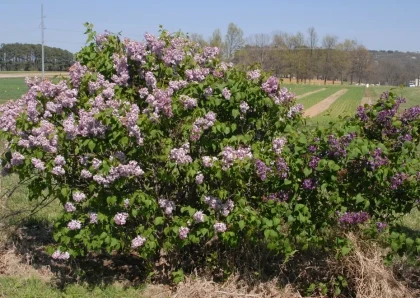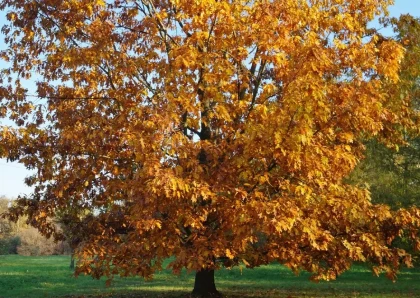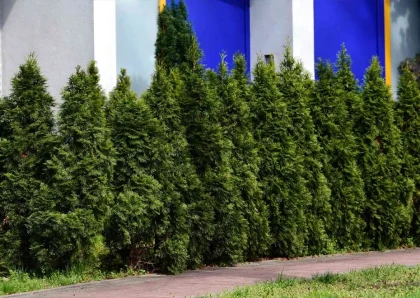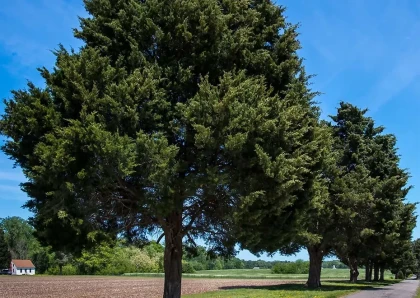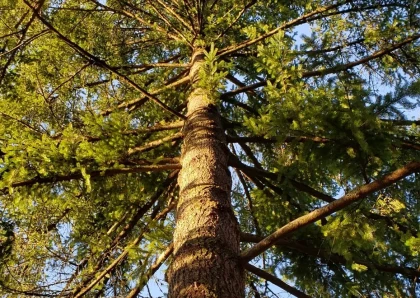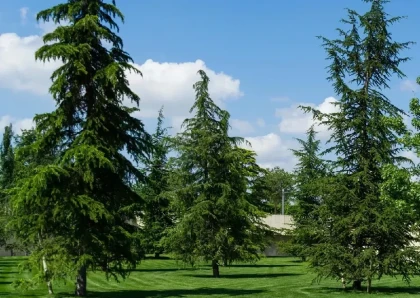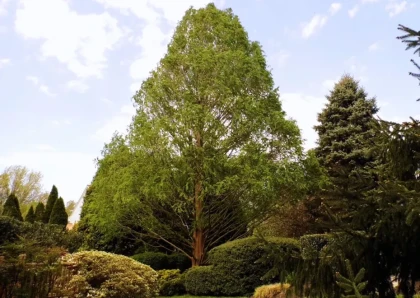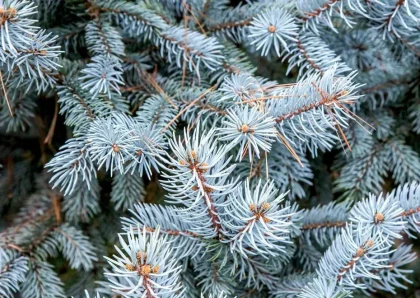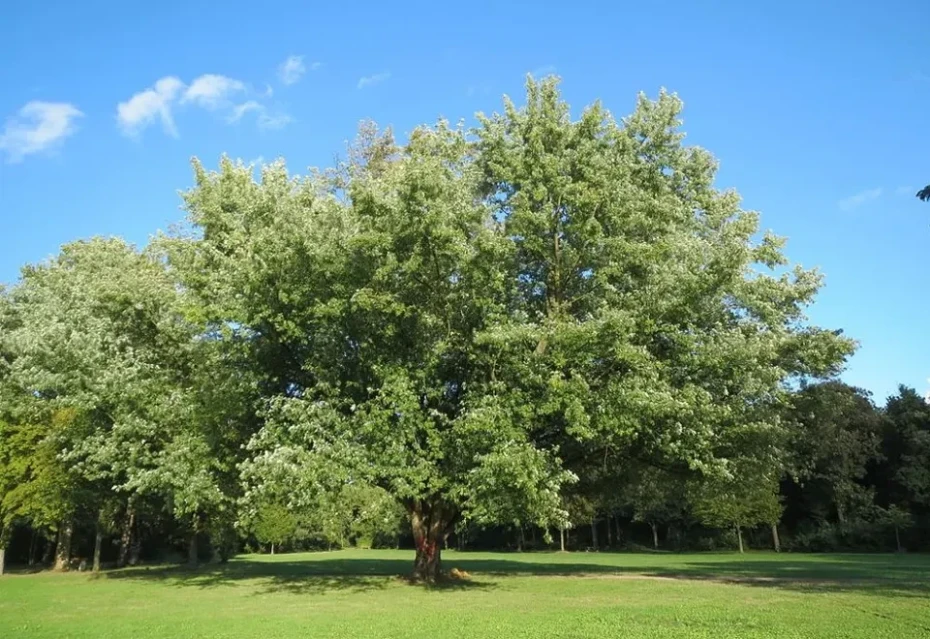
Silver Maple Tree
Overview
Silver Maple Tree
The Silver Maple (Acer saccharinum) is a deciduous tree native to eastern North America. It belongs to the Aceraceae family and is known for its rapid growth and distinctively lobed leaves with silver-white undersides.
Appearance
- Height: The Silver Maple can grow to be 50 to 80 feet tall, with some exceptional specimens reaching up to 100 feet.
- Leaves: The leaves are large and palmately lobed with five lobes. They have a silvery-white color on the underside, which gives the tree its name. In the fall, the leaves turn yellow, orange, or red before shedding.
- Bark: Young trees have smooth, silver-gray bark, which becomes darker and develops deep furrows as the tree matures.
- Flowers and Seeds: In early spring, the tree produces clusters of small, inconspicuous yellow-green flowers. After the flowers, the tree forms distinctive winged seeds known as "samara" or "helicopter seeds." These seeds have a paired wing that enables them to be carried by the wind, aiding in their dispersal.
Habitat and Range
The Silver Maple is well-adapted to various habitats and can thrive in wet, moist, and dry soils. It is commonly found near rivers, streams, and floodplains, but can also grow in urban areas.
Environmental Impact
The tree provides significant environmental benefits, offering shade and habitat for various wildlife species. Its dense foliage and root systems help in erosion control along riverbanks and water bodies.
Cultural and Practical Uses
The Silver Maple is frequently used for landscaping due to its fast growth and attractive foliage. It is also planted along streets and roads for its shade-providing qualities.
Care and Maintenance
The Silver Maple prefers well-drained soil and can tolerate a range of soil types. Adequate watering is essential, especially during dry spells, to support its growth. Regular pruning can help maintain its shape and remove dead or damaged branches.
Caution
The Silver Maple has shallow and aggressive root systems, which may cause issues if planted too close to buildings or structures.
Silver Maple Tree Types
Acer saccharinum
Acer saccharinum, commonly known as the Silver Maple, is the most well-known and widely distributed type of Silver Maple tree. It features distinctively lobed leaves with silver-white undersides.
Acer saccharinum 'Wieri'
Acer saccharinum 'Wieri', also known as the Silver Weeping Maple, is a cultivar of the Silver Maple with a weeping or pendulous growth habit. Its cascading branches make it an attractive ornamental tree.
Acer saccharinum 'Pyramidale'
Acer saccharinum 'Pyramidale', commonly called the Silver Pyramid Maple, has a more upright and columnar growth form, making it a suitable choice for landscapes with limited space.
Wood Products from Silver Maple Tree
Furniture
The Silver Maple wood is commonly used in furniture making due to its fine grain and attractive appearance. It is often used for crafting tables, chairs, cabinets, and decorative pieces.
Flooring
Silver Maple wood is a popular choice for hardwood flooring. Its light color and subtle grain patterns add a warm and inviting feel to interior spaces.
Cabinetry
Due to its easy workability and smooth finish, Silver Maple wood is utilized in making cabinets for kitchens, bathrooms, and other storage areas.
Millwork
Millwork products, such as moldings, trim, and paneling, can be crafted from Silver Maple wood to enhance the aesthetics of buildings and interior spaces.
Turning Projects
Woodworkers often use Silver Maple for turning projects, creating bowls, vases, and other artistic pieces on a lathe.
Benefits of the Silver Maple Tree
1. Fast Growth
The Silver Maple is known for its rapid growth, making it an excellent choice for providing quick shade and greenery in landscaping projects.
2. Aesthetic Appeal
The tree's large, palmately lobed leaves with silver-white undersides give it a distinct and attractive appearance, adding beauty to outdoor spaces.
3. Shade Provider
With its wide canopy, the Silver Maple offers ample shade during hot summer months, creating a cooler and more comfortable environment.
4. Wildlife Habitat
The dense foliage of the Silver Maple provides shelter and nesting sites for various bird species and other wildlife.
5. Erosion Control
The tree's extensive root system helps prevent soil erosion along riverbanks and water bodies, stabilizing the soil and protecting water quality.
6. Urban Tolerance
The Silver Maple can adapt well to urban environments and is often planted along streets and in parks to enhance green spaces in cities.
7. Wood Products
The Silver Maple wood is valuable for making furniture, flooring, cabinetry, and other woodworking projects due to its fine grain and workability.
Cons of Using the Silver Maple Tree
1. Weak Wood
The wood of the Silver Maple is relatively weak and prone to breakage during storms or heavy winds, making it less desirable for areas with frequent severe weather conditions.
2. Invasive Roots
The tree's root system can be aggressive and invasive, potentially causing damage to sidewalks, driveways, and underground utilities if planted too close to buildings.
3. Short Lifespan
Compared to some other tree species, the Silver Maple has a relatively short lifespan, typically ranging from 100 to 125 years, which may not be ideal for long-term landscaping plans.
4. Susceptible to Pests and Diseases
The Silver Maple is susceptible to various pests and diseases, such as aphids, scale insects, and fungal infections, which can affect its overall health and appearance.
5. Messy Foliage
The tree's large leaves can create a significant amount of leaf litter, requiring regular cleanup during the fall season.
6. Shallow Roots
The shallow root system of the Silver Maple can make it more vulnerable to uprooting during storms or when the soil becomes waterlogged.
Tips for Planting and Maintaining the Silver Maple Tree
1. Choose the Right Location
Select a planting location with well-drained soil and full to partial sunlight. Silver Maple trees can tolerate various soil types but thrive best in moist conditions.
2. Provide Adequate Water
Ensure the newly planted tree receives sufficient water, especially during dry periods. Regular watering is crucial for the establishment of the young tree.
3. Mulch the Base
Apply a layer of organic mulch around the base of the tree to conserve soil moisture and suppress weeds. Avoid piling the mulch against the trunk to prevent rotting.
4. Prune as Needed
Prune dead or damaged branches to maintain the tree's shape and overall health. Avoid heavy pruning during the growing season as it may stress the tree.
5. Watch for Pests and Diseases
Regularly inspect the tree for signs of pests or diseases. Early detection can help address issues promptly and prevent further damage.
6. Be Mindful of Root Space
Plant the Silver Maple tree away from structures, sidewalks, and underground utilities to prevent potential damage from the tree's invasive root system.
7. Fertilize Wisely
If necessary, apply a balanced fertilizer in the early spring to promote healthy growth. Follow the manufacturer's recommendations for proper application.
Conclusion
The Silver Maple tree, with its rapid growth, distinctively lobed leaves, and attractive appearance, is a popular choice for landscaping and urban environments. Its ability to provide shade, offer habitat for wildlife, and produce valuable wood products makes it a valuable addition to outdoor spaces.
However, careful consideration should be given to its planting location due to its invasive root system and susceptibility to pests and diseases. Regular maintenance, including proper watering, pruning, and monitoring for issues, will ensure the health and longevity of the Silver Maple tree in your landscape.
By following the tips provided and understanding its pros and cons, you can make the most of the Silver Maple tree's beauty and benefits in your garden or community.
FAQs - Silver Maple Tree
1. Are Silver Maple trees suitable for urban environments?
Yes, Silver Maple trees are well-suited for urban environments. They are often planted along streets and in parks due to their adaptability and aesthetic appeal.
2. How tall do Silver Maple trees typically grow?
Silver Maple trees can reach heights between 50 to 80 feet, with some exceptional specimens growing up to 100 feet.
3. Can Silver Maple trees tolerate wet soil?
Yes, Silver Maple trees are known for their ability to tolerate wet or moist soil conditions. They are commonly found near rivers, streams, and floodplains.
4. What kind of wood products can be made from Silver Maple?
Silver Maple wood is commonly used in furniture making, flooring, cabinetry, and turning projects due to its fine grain and workability.
5. Are Silver Maple trees fast-growing?
Yes, Silver Maple trees are considered fast-growing trees, making them popular choices for providing quick shade and greenery in landscapes.
6. How long do Silver Maple trees typically live?
The average lifespan of Silver Maple trees ranges from 100 to 125 years, which is relatively shorter compared to some other tree species.
No listings available
Related Products
Golden Jubilee Peach Tree
Prunus persica 'Golden Jubilee' is a specific cultivar of peach tree. It is a deciduous fruit tree belonging to the Rosaceae family. 'Golden Jubilee'...
Gray Dogwood
Cornus racemosa, commonly known as the gray dogwood or northern swamp dogwood, is a deciduous shrub native to eastern North America. It belongs to...
Common Fragrant Lilac
Syringa vulgaris, commonly known as the Common Lilac or French Lilac, is a deciduous shrub belonging to the genus Syringa in the olive family...
European Beech Tree
The European Beech (Fagus sylvatica) is a deciduous tree species native to much of Europe, including parts of western Asia. It is one of...
Emerald Arborvitae Tree
The Emerald Arborvitae (Thuja occidentalis 'Smaragd') is a popular evergreen tree or shrub in landscaping and gardening. It belongs to the cypress family (Cupressaceae)...
Eastern Red Cedar Tree
The Eastern Red Cedar, scientifically known as Juniperus virginiana, is a species of evergreen tree native to eastern North America. It belongs to the...
Douglas Fir Tree
The Douglas Fir (Pseudotsuga menziesii) is an evergreen coniferous tree that belongs to the Pinaceae family. It is one of the most common and...
Deodar Cedar Tree
The name "Deodar" is derived from the Sanskrit words "deva" (meaning "god") and "daru" (meaning "wood" or "tree"), hence it is often referred to...
Dawn Redwood Tree
The Dawn Redwood tree, scientifically known as Metasequoia glyptostroboides, is a deciduous coniferous tree that belongs to the family Cupressaceae. It is a unique...
Colorado Blue Spruce Tree
The Colorado Blue Spruce, scientifically known as Picea pungens, is a species of coniferous tree belonging to the Pinaceae family. It is native to...




